最新版PEP小学英语句型与时态总复习小升初
- 格式:ppt
- 大小:150.00 KB
- 文档页数:91
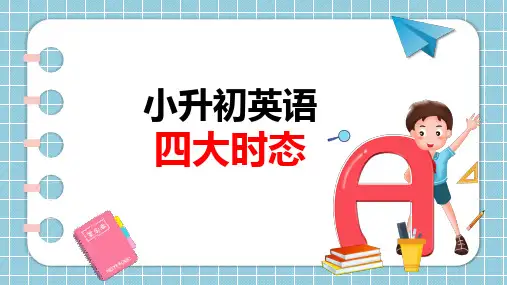
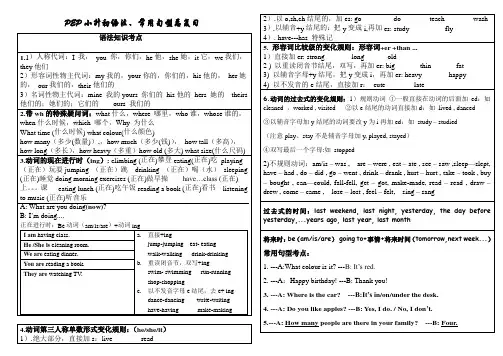
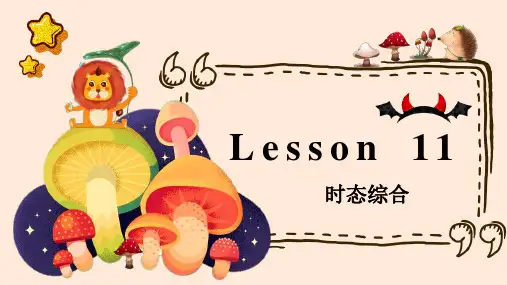
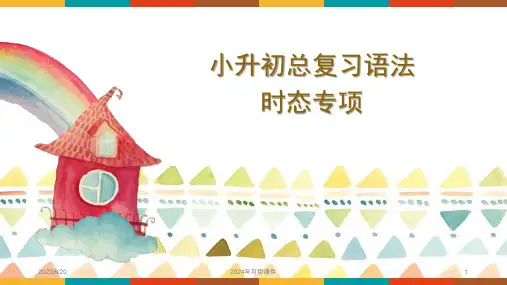
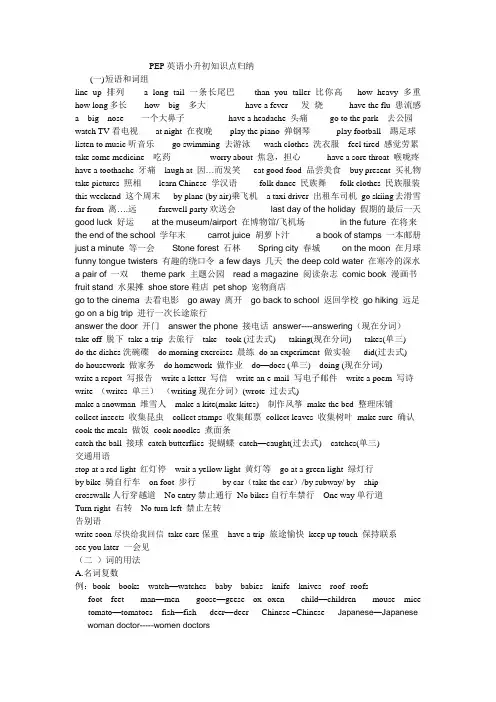
PEP英语小升初知识点归纳(一)短语和词组line up 排列 a long tail 一条长尾巴than you taller 比你高how heavy 多重how long多长how big 多大have a fever 发烧have the flu 患流感a big nose 一个大鼻子have a headache 头痛go to the park 去公园watch TV看电视at night 在夜晚play the piano 弹钢琴play football 踢足球listen to music听音乐go swimming 去游泳wash clothes 洗衣服feel tired 感觉劳累take some medicine 吃药worry about 焦急,担心have a sore throat 喉咙疼have a toothache 牙痛laugh at 因…而发笑eat good food 品尝美食buy present 买礼物take pictures 照相learn Chinese 学汉语folk dance 民族舞folk clothes 民族服装this weekend 这个周末by plane (by air)乘飞机 a taxi driver 出租车司机go skiing去滑雪far from 离….远farewell party欢送会last day of the holiday 假期的最后一天good luck 好运at the museum/airport 在博物馆/飞机场in the future 在将来the end of the school 学年末carrot juice 胡萝卜汁 a book of stamps 一本邮册just a minute 等一会Stone forest 石林Spring city 春城on the moon 在月球funny tongue twisters 有趣的绕口令a few days 几天the deep cold water 在寒冷的深水a pair of 一双theme park 主题公园read a magazine 阅读杂志comic book 漫画书fruit stand 水果摊shoe store鞋店pet shop 宠物商店go to the cinema 去看电影go away 离开go back to school 返回学校go hiking 远足go on a big trip 进行一次长途旅行answer the door 开门answer the phone 接电话answer----answering(现在分词)take off 脱下take a trip 去旅行take---took (过去式) taking(现在分词) takes(单三)do the dishes洗碗碟do morning exercises 晨练do an experiment 做实验did(过去式)do housework 做家务do homework 做作业do—does (单三) doing (现在分词)write a report 写报告write a letter 写信write an e-mail 写电子邮件write a poem 写诗write (writes 单三)(writing现在分词)(wrote 过去式)make a snowman 堆雪人make a kite(make kites) 制作风筝make the bed 整理床铺collect insects 收集昆虫collect stamps 收集邮票collect leaves 收集树叶make sure 确认cook the meals 做饭cook noodles 煮面条catch the ball 接球catch butterflies 捉蝴蝶catch—caught(过去式) catches(单三)交通用语stop at a red light 红灯停wait a yellow light 黄灯等go at a green light 绿灯行by bike 骑自行车on foot 步行by car(take the car)/by subway/ by ship crosswalk人行穿越道No entry禁止通行No bikes自行车禁行One way单行道Turn right 右转No turn left 禁止左转告别语write soon尽快给我回信take care保重have a trip 旅途愉快keep up touch 保持联系see you later 一会见(二)词的用法A.名词复数例:book---books watch—watches baby---babies knife---knives roof--roofs foot---feet man—men goose—geese ox--oxen child—children mouse---mice tomato—tomatoes fish—fish deer—deer Chinese –Chinese Japanese—Japanese woman doctor-----women doctorsB.冠词例:a worker a pen an hour an apple an orange the pictureC.代词例:I(主格)---me(宾格)my(形容词物主代词)-----mine(名词性物主代词) You ----you your ---- yoursHe -----him his ------ hisShe ----her her ------hersWe ---us our ------oursYou ---you your ------yoursThey -- them their -------theirs(注:This is my jacket.(同义句) This jacket is mine.D.数词.基数词one two three four …..序数词first second third fourth fifth eighth ninth twentieth thirty—first(第三十一)F.形容词比较级和最高级例:tall—taller big---bigger heavy—heavier late—later beautiful—more beautiful good/well---better---best(最高级) many/much---more---most(最高级)ill/bad----worse-----worst(最高级) little-------less---------least(最高级)old---older/elder—oldest/eldest(最高级) far—farther/further—farthest/furthest(最高级) 例句:I am taller than your brother. He is shorter than me.(三)英语时态的简单用法A..一般现在时(当主语是单数第三人称时,谓语动词要发生相应的变化,即单三形式)(always usually often sometimes never every day …..这些词出现体现一般现在时)例1.)He always helps others. 他总是帮助别人。
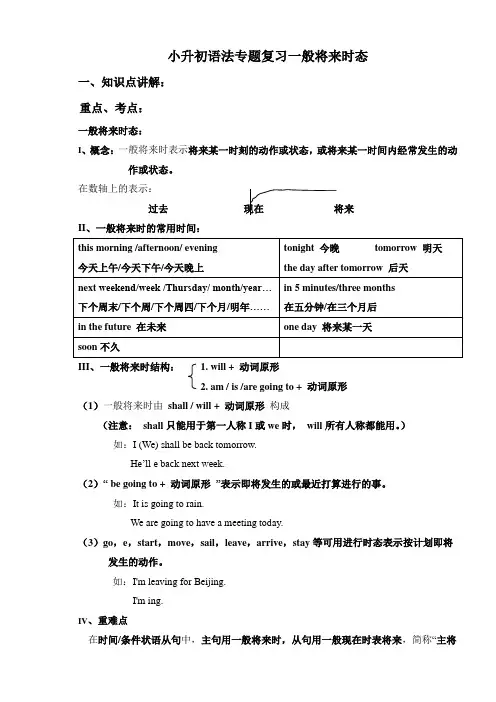
小升初语法专题复习一般将来时态一、知识点讲解:重点、考点:一般将来时态:I 、概念:一般将来时表示将来某一时刻的动作或状态,或将来某一时间内经常发生的动作或状态。
在数轴上的表示:过去现在 将来II 、一般将来时的常用时间:III 、一般将来时结构: 1. will + 动词原形2. am / is /are going to + 动词原形(1)一般将来时由 shall / will + 动词原形 构成(注意: shall 只能用于第一人称I 或we 时, will 所有人称都能用。
) 如:I (We) shall be back tomorrow.He’ll e back next week.(2)“ be going to + 动词原形 ”表示即将发生的或最近打算进行的事。
如:It is going to rain.We are going to have a meeting today.(3)go ,e ,start ,move ,sail ,leave ,arrive ,stay 等可用进行时态表示按计划即将发生的动作。
如:I'm leaving for Beijing.I'm ing.IV 、重难点在时间/条件状语从句中,主句用一般将来时,从句用一般现在时表将来,简称“主将从现”;常见的从句引导词为:when、if 、as soon as 等。
如:If it ________( not rain) tomorrow , we ________(go) to the park.I ________(be) a doctor when I ________(grow) up.I ________ (call) you as soon as he ________(e) back.V、一般将来时态与句型(**)(1)变为否定句:在be动词(am, is, are)后加not,或情态动词will后加not成won’t。
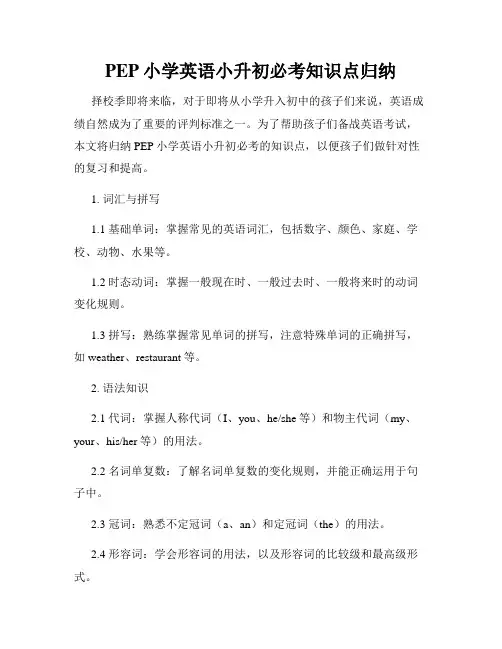
PEP小学英语小升初必考知识点归纳择校季即将来临,对于即将从小学升入初中的孩子们来说,英语成绩自然成为了重要的评判标准之一。
为了帮助孩子们备战英语考试,本文将归纳PEP小学英语小升初必考的知识点,以便孩子们做针对性的复习和提高。
1. 词汇与拼写1.1 基础单词:掌握常见的英语词汇,包括数字、颜色、家庭、学校、动物、水果等。
1.2 时态动词:掌握一般现在时、一般过去时、一般将来时的动词变化规则。
1.3 拼写:熟练掌握常见单词的拼写,注意特殊单词的正确拼写,如weather、restaurant等。
2. 语法知识2.1 代词:掌握人称代词(I、you、he/she等)和物主代词(my、your、his/her等)的用法。
2.2 名词单复数:了解名词单复数的变化规则,并能正确运用于句子中。
2.3 冠词:熟悉不定冠词(a、an)和定冠词(the)的用法。
2.4 形容词:学会形容词的用法,以及形容词的比较级和最高级形式。
2.5 介词:掌握常用介词的用法,如in、on、at等。
2.6 动词词组:掌握一些常用的动词词组,如look after、take care of 等。
3. 句型与表达3.1 Be动词句型:掌握“主语+be动词+形容词/名词”句型的用法,如I am happy、He is a teacher等。
3.2 疑问句:学会用be动词和助动词构成疑问句,如Are you a student?、Can you swim?等。
3.3 祈使句:了解祈使句的基本结构,如Wash your hands before eating.等。
3.4 感叹句:了解感叹句的表达方式,如How beautiful!、What anice day!等。
3.5 日常交际用语:熟练掌握日常用语,如问候语、道谢、道歉等。
4. 阅读理解4.1 短文阅读:学会从短文中获取信息,并正确回答问题。
4.2 图片阅读:学会看图并理解其含义,回答相关问题。
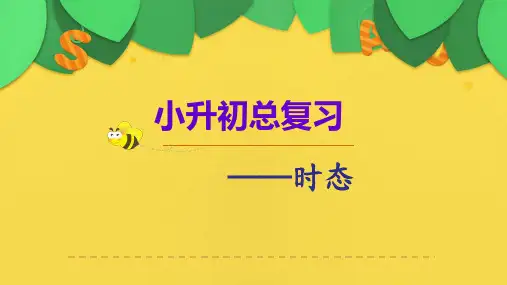
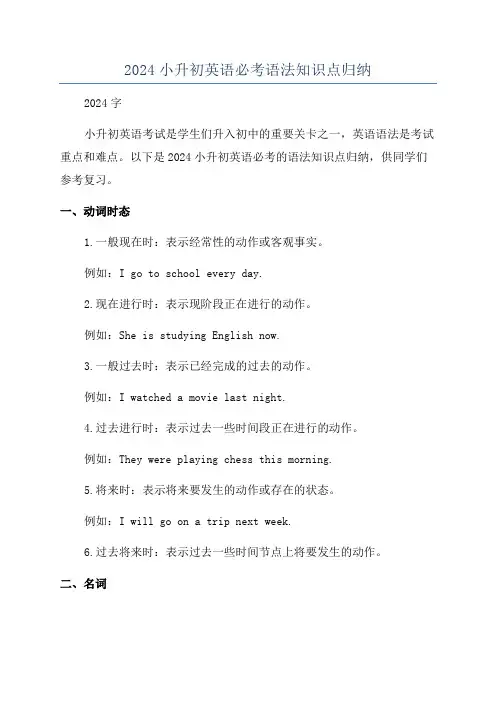
2024小升初英语必考语法知识点归纳2024字小升初英语考试是学生们升入初中的重要关卡之一,英语语法是考试重点和难点。
以下是2024小升初英语必考的语法知识点归纳,供同学们参考复习。
一、动词时态1.一般现在时:表示经常性的动作或客观事实。
例如:I go to school every day.2.现在进行时:表示现阶段正在进行的动作。
例如:She is studying English now.3.一般过去时:表示已经完成的过去的动作。
例如:I watched a movie last night.4.过去进行时:表示过去一些时间段正在进行的动作。
例如:They were playing chess this morning.5.将来时:表示将来要发生的动作或存在的状态。
例如:I will go on a trip next week.6.过去将来时:表示过去一些时间节点上将要发生的动作。
二、名词1.可数名词与不可数名词:可数名词有单数和复数之分,不可数名词只有单数形式。
例如:table(可数), water(不可数)2.名词所有格:表示所有关系时,在名词后加's。
例如:Tom's book(汤姆的书)3.复合名词:由两个或两个以上名词构成并有一定结构的名词。
例如:classroom, basketball三、形容词与副词1.形容词用来修饰名词,副词用来修饰动词、形容词或其他副词。
例如:She is a beautiful girl.(形容词修饰名词)He runs fast.(副词修饰动词)2. 形容词的比较级和最高级:一般在形容词后面加-er表示比较级,在形容词前面加the最高级。
例如:He is taller than me.(比较级)He is the tallest boy in our class.(最高级)四、代词1. 人称代词:主格形式有I, you, he, she, it, we, they;宾格形式有me, you, him, her, it, us, them。

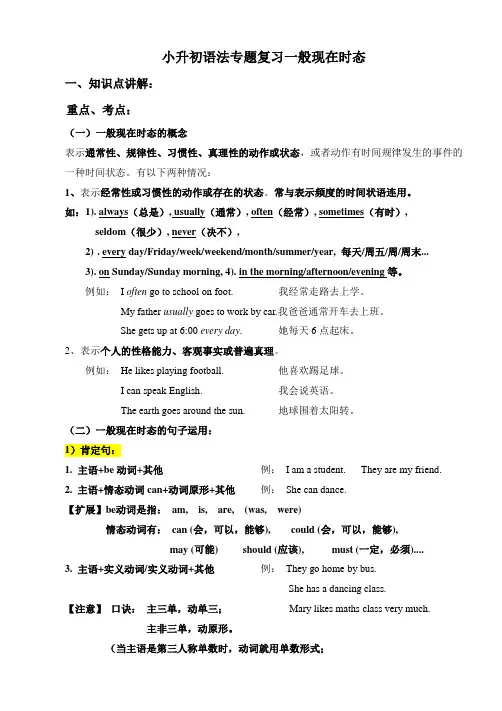
小升初语法专题复习一般现在时态一、知识点讲解:重点、考点:(一)一般现在时态的概念表示通常性、规律性、习惯性、真理性的动作或状态,或者动作有时间规律发生的事件的一种时间状态。
有以下两种情况:1、表示经常性或习惯性的动作或存在的状态。
常与表示频度的时间状语连用。
如:1). always(总是), usually(通常), often(经常), sometimes(有时), seldom(很少), never(决不),2). every day/Friday/week/weekend/month/summer/year, 每天/周五/周/周末...3). on Sunday/Sunday morning, 4). in the morning/afternoon/evening等。
例如:I often go to school on foot. 我经常走路去上学。
My father usually goes to work by car.我爸爸通常开车去上班。
She gets up at 6:00 every day. 她每天6点起床。
2、表示个人的性格能力、客观事实或普遍真理。
例如:He likes playing football. 他喜欢踢足球。
I can speak English. 我会说英语。
The earth goes around the sun. 地球围着太阳转。
(二)一般现在时态的句子运用:1)肯定句:1. 主语+be动词+其他例:I am a student. They are my friend.2. 主语+情态动词can+动词原形+其他例:She can dance.【扩展】be动词是指:am, is, are, (was, were)情态动词有:can (会,可以,能够), could (会,可以,能够),may (可能) should (应该), must (一定,必须)....3. 主语+实义动词/实义动词+其他例:They go home by bus.She has a dancing class.【注意】口诀:主三单,动单三;Mary likes maths class very much.主非三单,动原形。